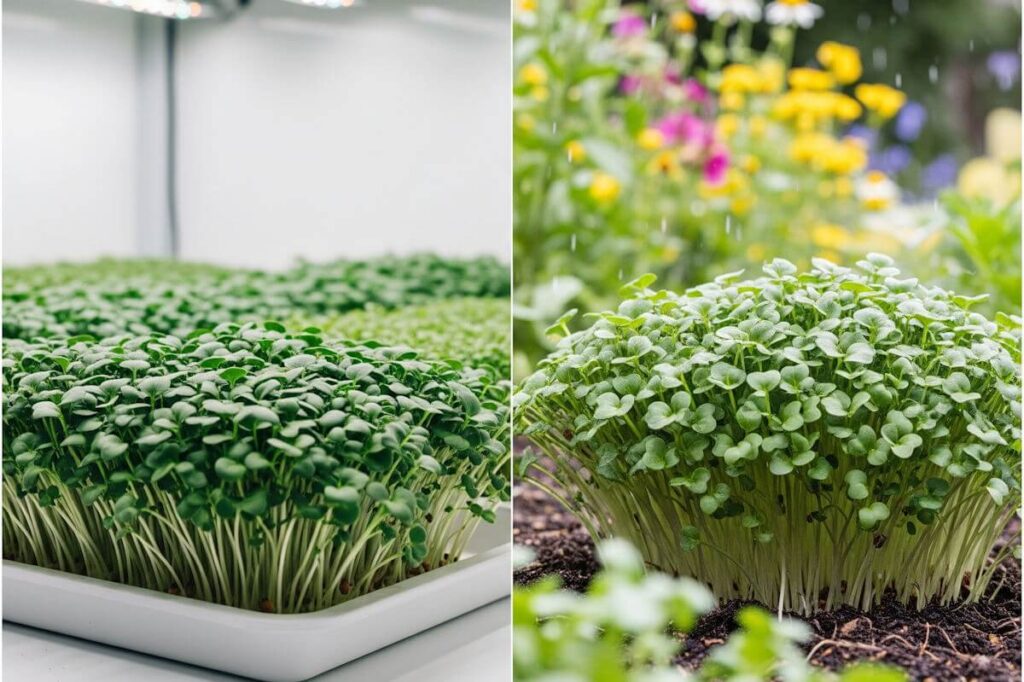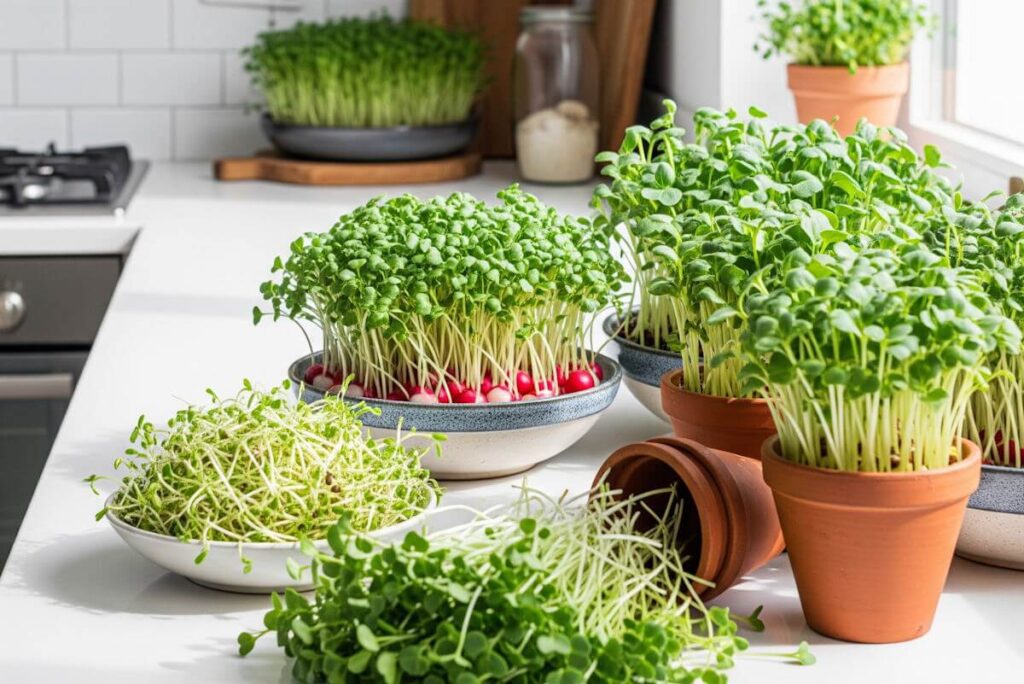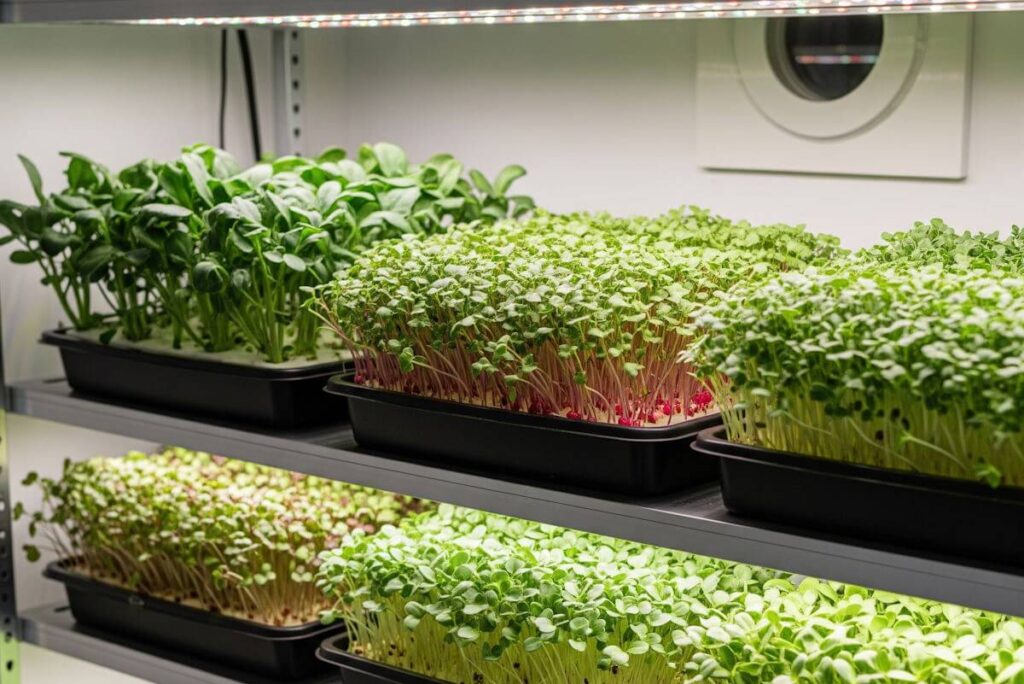Microgreens are young edible plants that are harvested at an early stage of growth, typically just after the first true leaves, known as cotyledons, have developed. These vibrant, miniature greens are not only visually appealing but also pack a significant nutritional punch. They have gained remarkable popularity in recent years, especially within the culinary world, where they are used to enhance the presentation and flavor profile of various dishes. Chefs and home cooks alike have embraced microgreens for their versatility and ability to add both texture and taste to salads, sandwiches, and garnishes.
The nutritional benefits of microgreens are substantial. Studies suggest that many varieties contain higher concentrations of vitamins, minerals, and antioxidants compared to their mature counterparts. For example, microgreens like broccoli, radish, and kale are known to be rich in essential nutrients such as vitamins C, E, and K, as well as various phytonutrients that contribute to overall health and well-being. Incorporating these nutritious greens into daily diets can be a simple yet effective way to boost overall health.
There are many different types of microgreens, each with unique flavors and characteristics. Common varieties include arugula, basil, cilantro, and beet greens, among others. These types can be grown in a variety of conditions, making them accessible to both novice and experienced gardeners. Furthermore, microgreens can be cultivated both indoors and outdoors, providing flexibility depending on available space and climate. As sustainability and healthy eating gain traction, the cultivation and consumption of microgreens exemplify a growing trend towards nutritious and locally sourced food options.
Benefits of Growing Microgreens
Microgreens are not only a flavorful addition to various dishes but also pack a wealth of health benefits, making them an appealing option for both novice and experienced gardeners. One of the primary advantages of growing microgreens is their impressive nutrient profile. Research has shown that many microgreens contain significantly higher concentrations of vitamins and minerals than their mature counterparts. For instance, varieties such as broccoli, kale, and radish have been noted to possess elevated levels of vitamins C, E, and K, along with essential minerals like calcium and magnesium. This nutrient density contributes to a healthier diet, making microgreens an attractive choice for those aiming to enhance their overall wellness.
Another significant benefit is the quick growth cycle associated with microgreens. Unlike traditional gardening, which can take months to yield a harvest, microgreens can be ready for consumption within 7 to 21 days after planting. This rapid growth allows for a continuous supply of fresh greens, supporting a healthy eating pattern. Furthermore, their small size and minimal cultivation requirements make them suitable for various growing environments, from small urban apartments to larger outdoor spaces.
Beyond their health benefits and fast growth, microgreens also exhibit remarkable versatility in cooking. They can be used to elevate a wide range of dishes, from salads and sandwiches to soups and garnishes, adding flavor, texture, and color. Additionally, growing microgreens can be considered a sustainable gardening option, as it requires less water, soil, and space compared to traditional farming methods. This ecological advantage not only reduces the carbon footprint associated with transporting food but also promotes the practice of growing one’s own food, fostering a deeper appreciation for agricultural resources.
Indoor Microgreens Growing: Pros and Cons
Indoor microgreens growing offers numerous advantages that appeal to both novice and experienced gardeners. One key benefit is the ability to control the growing environment meticulously. Indoor settings allow for optimal light, temperature, and humidity regulation. By using grow lights and heaters, enthusiasts can create the perfect conditions for microgreens to thrive year-round, regardless of outdoor climate fluctuations. This consistent environment reduces the risks associated with unpredictable weather, enabling a more reliable harvest throughout the seasons.
Another advantage of indoor growing is ease of access. Gardening indoors means that growers have immediate access to their crops, fostering convenience and reducing the time and effort involved in cultivation. Additionally, indoor environments are generally protected from pests and diseases common in outdoor gardens, thus minimizing the need for chemical interventions. This protection contributes to healthier microgreens and a safer growing experience, particularly for those concerned about pesticides and their impact on health.
However, growing microgreens indoors presents certain limitations. Space constraints can be a significant challenge, particularly for those with small living conditions. Adequate space is necessary for trays to be positioned in locations with enough light, often leading to careful planning around available areas. Furthermore, indoor gardens may suffer from reduced air circulation, which can hinder plant growth and promote mold or fungal issues. As microgreens rely on well-ventilated environments, growers may need to incorporate fans or proper ventilation systems to ensure adequate airflow.
In conclusion, while indoor microgreens growing provides benefits like environmental control, ease of access, and reduced pest risks, potential issues related to space and air circulation must be addressed for optimal cultivation. Awareness of these pros and cons helps gardeners make informed decisions regarding their microgreens growing methods.
Outdoor Microgreens Growing: Pros and Cons
Growing microgreens outdoors offers several advantages that can significantly enhance the cultivation experience. One of the primary benefits of outdoor microgreens gardening is the availability of natural sunlight. Unlike indoor setups, which may necessitate the use of artificial grow lights, outdoor growing allows plants to receive direct sunlight, which is crucial for their growth. This exposure to sunlight can result in healthier and more vibrant microgreens, often enhancing their flavor and nutritional value.
Additionally, outdoor spaces typically provide a larger area for cultivation compared to indoor environments. This aspect is especially beneficial for those who wish to scale their microgreens production. With a larger growing area, one can experiment with different varieties and produce larger quantities, catering to personal use or even local markets. Moreover, the natural soil and environmental conditions can sometimes yield better growth outcomes than container gardening indoors, where soil composition may be more challenging to manage.
However, there are also notable challenges associated with outdoor microgreens growing. Weather variability poses a significant risk, as factors such as excessive rain, wind, or extreme temperatures can adversely affect the growing conditions. Unlike controlled indoor environments where conditions can be meticulously regulated, outdoor gardens are subject to the whims of nature. This unpredictability can lead to crop losses and compromises in quality.
Pest pressure is another concern when growing microgreens outdoors. While beneficial insects can help in maintaining a balanced ecosystem, harmful pests may also invade, jeopardizing plant health. Regular monitoring and management strategies become essential in mitigating these risks. Finally, outdoor gardening is subject to seasonal limitations, whereby certain microgreens may only thrive during specific periods of the year, thus restricting the growing cycle. Consideration of these pros and cons is vital for anyone contemplating outdoor microgreens cultivation.
Light Requirements for Microgreens
Light is a critical factor in the successful growth of microgreens, as it directly influences the plants’ photosynthesis process and, consequently, their overall health and yield. When it comes to growing microgreens, there are two primary environments to consider: indoor artificial lighting and outdoor sunlight. Each option presents its unique benefits and challenges.
Indoor grow setups often utilize various types of artificial lighting, including fluorescent lights, LED grow lights, and high-intensity discharge (HID) lights. Among these, LED grow lights have gained popularity due to their energy efficiency and customizable light spectrum options. Most microgreens require between 12 to 16 hours of light daily to thrive. It is crucial to ensure that the light source is positioned adequately to avoid both overshadowing and overheating the seedlings. A general recommendation is to keep the lights about 4 to 12 inches above the plants, adjusting the height as necessary based on the specific growth stage of the microgreens.
On the other hand, growing microgreens outdoors allows them to benefit from natural sunlight. Sunlight provides a full spectrum of light, which is advantageous for plant growth; however, outdoor growing does have limitations, as it is subject to weather conditions and seasonal changes. The intensity of sunlight can vary significantly, necessitating careful monitoring to prevent overheating or drying out the plants. Various microgreens, such as basil and broccoli, thrive well in full sun, while others, like cilantro and pea shoots, prefer partial shade.
Optimizing light conditions is vital for successful microgreens cultivation. Indoor growers can supplement natural light with artificial sources, while outdoor growers can strategically position their trays to maximize sunlight exposure. Ultimately, whether indoors or outdoors, understanding the light requirements of specific microgreens is essential to achieving optimal growth and harvest. By carefully managing light conditions, growers can ensure their crops flourish, resulting in healthy and vibrant microgreens.
Watering and Soil Considerations
Watering and soil requirements are critical factors in successfully cultivating microgreens, whether indoors or outdoors. Microgreens are generally grown in a shallow layer of soil or a hydroponic medium, making the choice of soil mix and watering routine pivotal for their growth. Proper drainage is essential to prevent waterlogging, which can lead to root rot and other complications. Thus, planting microgreens in high-quality potting soil or a specially formulated seed-starting mix is advisable, as these options typically provide the necessary aeration and drainage.
Indoors, microgreens benefit from a consistent watering routine, as the environment tends to be controlled and less prone to natural precipitation. A common practice is to water from below by placing the containers in a tray of water, allowing the soil to absorb moisture without saturating the leaves. This method promotes healthy root development while reducing the risk of mold and mildew. Indoor growers might need to monitor humidity levels closely, as indoor air can be drier compared to outdoor conditions. Adjusting the watering frequency based on the ambient humidity will ensure that microgreens receive just the right amount of moisture.
In contrast, outdoor microgreens are subject to varying weather conditions, which can significantly affect their watering needs. Rainfall can supplement natural moisture, but during drier periods, outdoor growers must manually irrigate to ensure the soil remains adequately moist. Using drip irrigation systems can enhance efficiency and prevent overwatering. The outdoor soil typically retains moisture differently due to factors like texture, organic matter content, and drainage capability. Therefore, the choice of soil amendments and the timing of watering can differ based on local climate conditions.
Overall, understanding the distinct watering needs and soil preferences for indoor and outdoor microgreens is vital for achieving optimal growth and yield.
Pest Management Strategies
When cultivating microgreens, whether indoors or outdoors, effective pest management is crucial to ensure healthy growth and yield. Different growing environments can influence the types of pests and diseases that microgreens may encounter, making it imperative to tailor management strategies accordingly.
In indoor settings, common pests include aphids, fungus gnats, and spider mites. The enclosed space can facilitate rapid pest proliferation due to the lack of natural predators. To prevent these pests, maintaining proper humidity levels and air circulation is essential. Utilizing sticky traps can help monitor and control pest populations effectively. Additionally, introducing natural predators like ladybugs or predatory mites can also mitigate pest issues. Regularly inspecting plants and ensuring cleanliness in the growing area can significantly reduce the risk of infestations.
Conversely, outdoor microgreens are often exposed to a wider range of pests, including slugs, snails, and various beetles. The primary challenge in outdoor growth is not only managing these pests but also dealing with the potential for diseases. Crop rotation and intercropping can be effective strategies in minimizing pest populations. Furthermore, using row covers provides a physical barrier against insects, while allowing sunlight and moisture to reach the plants. Employing organic pesticides, such as neem oil or insecticidal soap, can also serve as a solution for any persistent pest issues, albeit with careful consideration of their impact on beneficial insects.
Regardless of the environment, sanitation plays a vital role in pest management. Removing any dead plant material and regularly cleaning equipment will help prevent pest populations from establishing. For both indoor and outdoor microgreens, cultivating healthy plants through proper nutrient management and watering practices contributes significantly to their ability to resist pests. Understanding the specific pest challenges faced in each environment aids in the development of a comprehensive pest management approach, fostering the successful growth of microgreens.
Cost Analysis: Indoor vs. Outdoor Growing
When comparing indoor and outdoor microgreens growing methods, a thorough cost analysis is essential for any aspiring cultivator. Understanding the financial requirements involved in each approach can significantly affect one’s decision-making process. This analysis will focus on startup costs, ongoing expenses, and potential yield differences associated with both indoor and outdoor microgreens cultivation.
Indoor microgreens growing typically entails higher initial investment costs. Growers need to purchase specialized equipment such as grow lights, fans, and climate-control systems to create a suitable environment for plant growth. Additionally, purchasing soil, trays, and seeds contributes to these upfront expenses. Depending on the level of automation selected, costs can escalate quickly. Conversely, outdoor microgreens growing generally requires less initial financial input. Utilizing natural sunlight and outside space eliminates the need for specialized lighting and climate control systems. Basic equipment may still be necessary, such as trays and soil, but these expenses are usually lower when compared to indoor setups.
Ongoing expenses also exhibit significant differences between the two methods. Indoor growing often incurs higher energy bills due to the reliance on artificial lighting and climate control to maintain optimal conditions. Conversely, outdoor growing typically benefits from minimal ongoing utility expenses, as natural sunlight is utilized. However, outdoor cultivators may need to account for pest management and weather-related challenges, which could lead to variability in costs over time.
In terms of yield differences, indoor microgreens often produce faster turnaround times due to controlled conditions, which can lead to more consistent production cycles. Outdoor microgreens can be more susceptible to environmental changes, potentially leading to reduced yields in adverse weather conditions. Therefore, a careful analysis of both startup costs, ongoing expenses, and yield outcomes is crucial for determining which growing method will be the most cost-effective choice for your microgreens venture.
Conclusion: Making the Right Choice for You
When deciding between indoor and outdoor microgreens growing, several key factors come into play that can influence your choice. Throughout this blog post, we have explored the benefits and challenges associated with both methods, highlighting how each can cater to different lifestyles and conditions. An important aspect to consider is the available space you have for cultivating microgreens. Indoor growing setups are often more adaptable, allowing for creative solutions in limited areas. This flexibility can be particularly beneficial for urban dwellers or those with smaller living environments.
On the other hand, outdoor microgreens growing typically offers greater access to natural sunlight and potentially more robust growing conditions. If you have ample outdoor space and live in a suitable climate, growing microgreens outside may lead to larger yields and healthier plants. Moreover, outdoor cultivation often requires fewer artificial resources, which can be a consideration for those looking to minimize their carbon footprint.
Resources such as time, equipment, and financial investment also play a critical role in making your decision. Indoor growing may necessitate purchasing additional supplies like grow lights and soil, while outdoor growing might involve dealing with pests and varying weather conditions. Your personal preferences, including how much time you can dedicate to maintaining your microgreens and whether you prefer the convenience of indoor gardening or the fresh air and hands-on approach of outdoor gardening, should also be evaluated.
Ultimately, the decision between indoor and outdoor microgreens growing rests on your unique circumstances, preferences, and goals. By taking the time to reflect on these points and assessing your specific environment, you will be better equipped to choose the method that aligns with your lifestyle and aspirations for growing these nutritious and flavorful additions to your diet.




